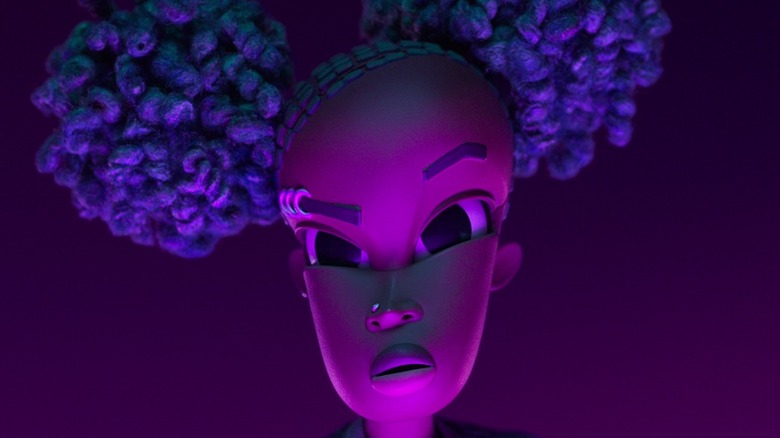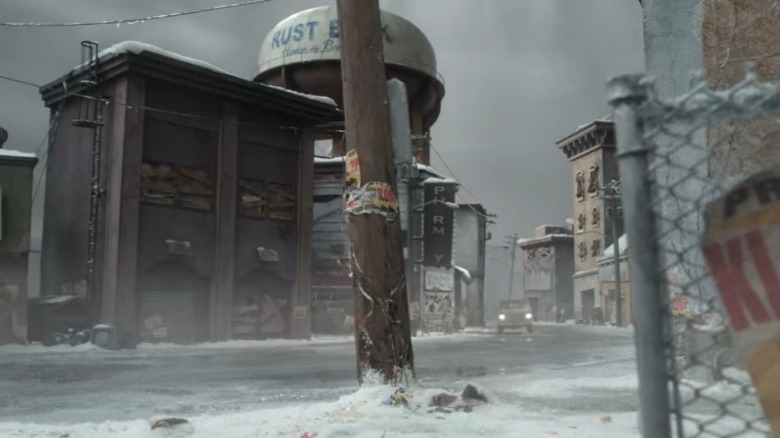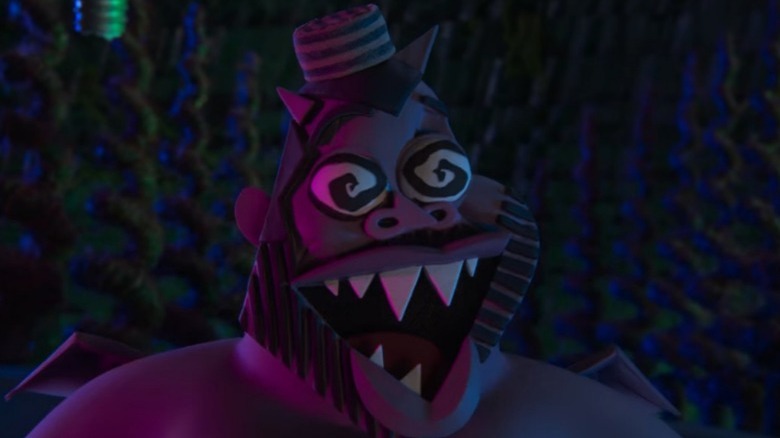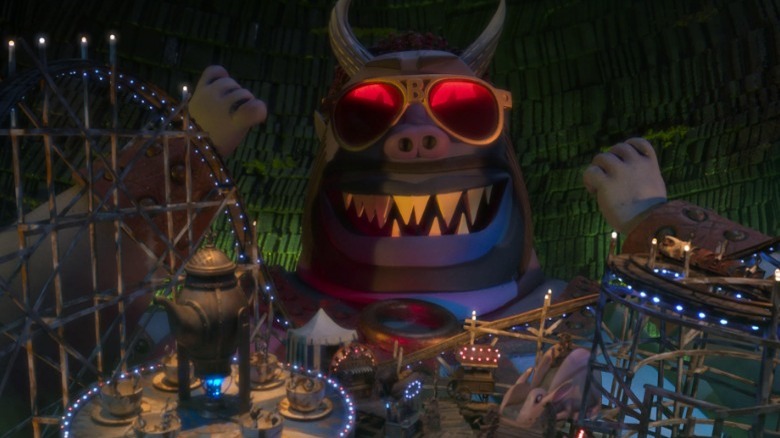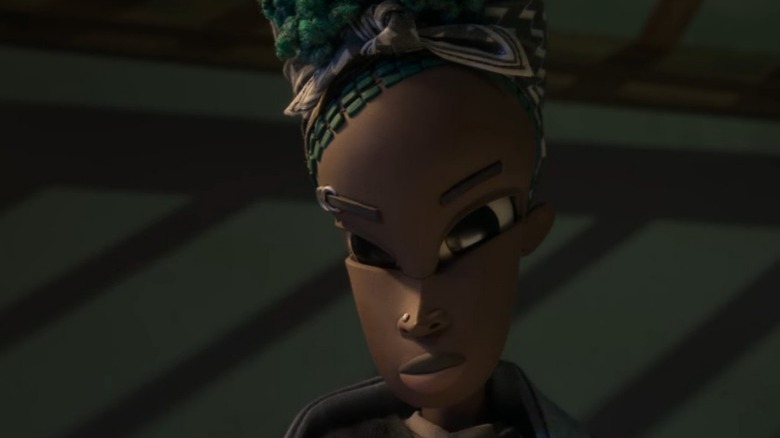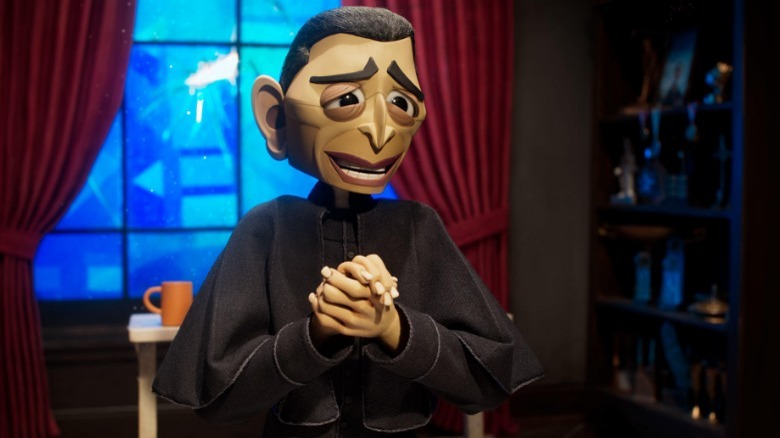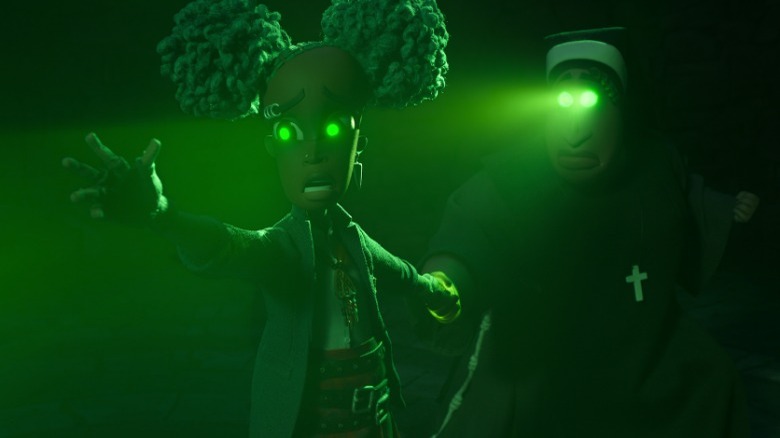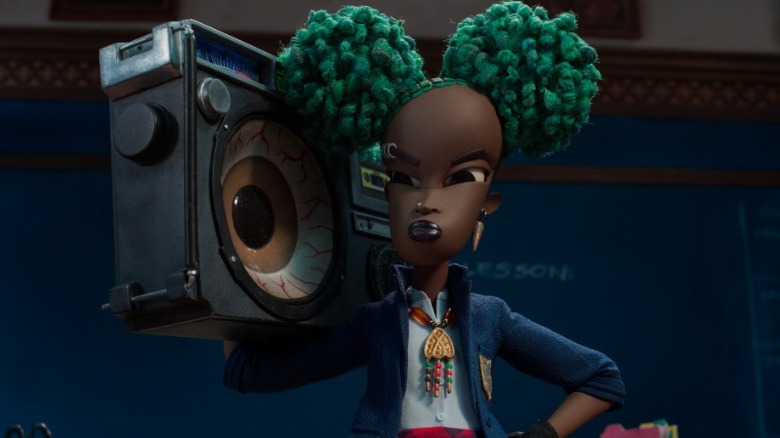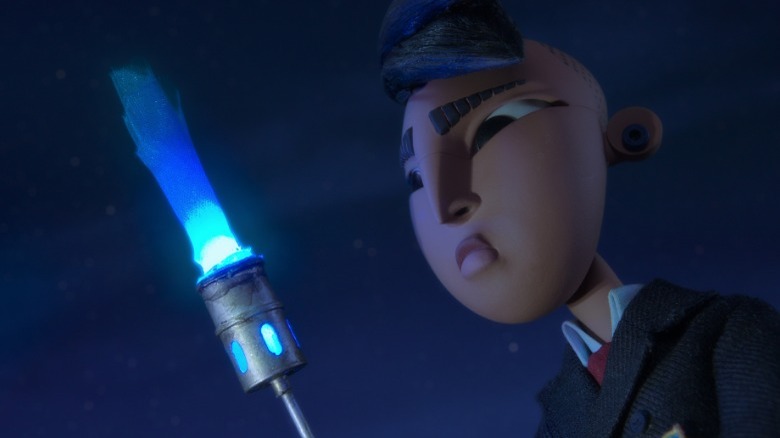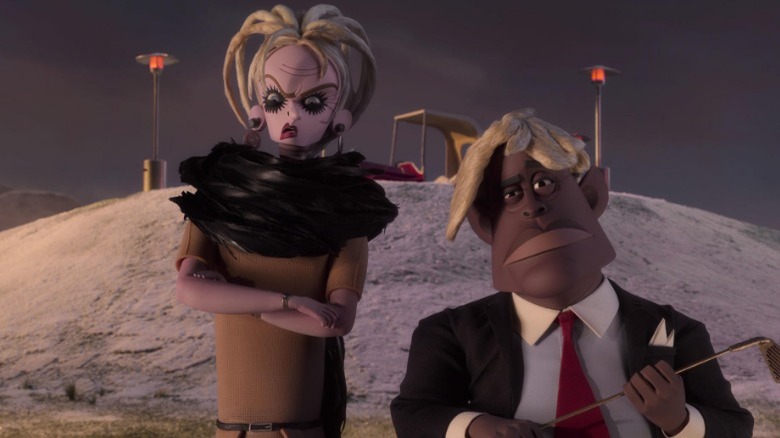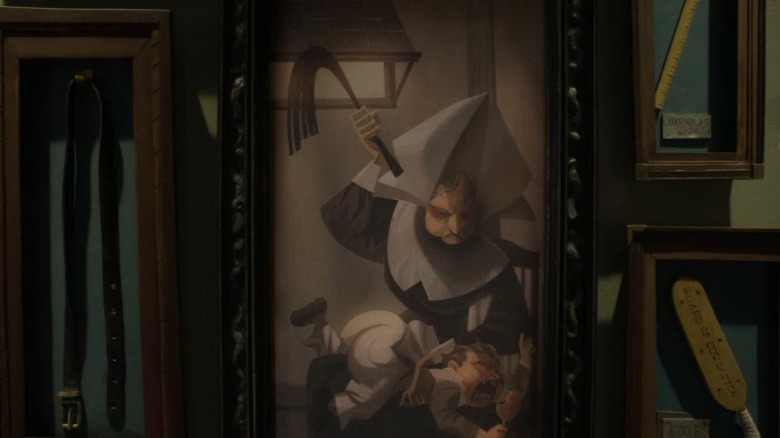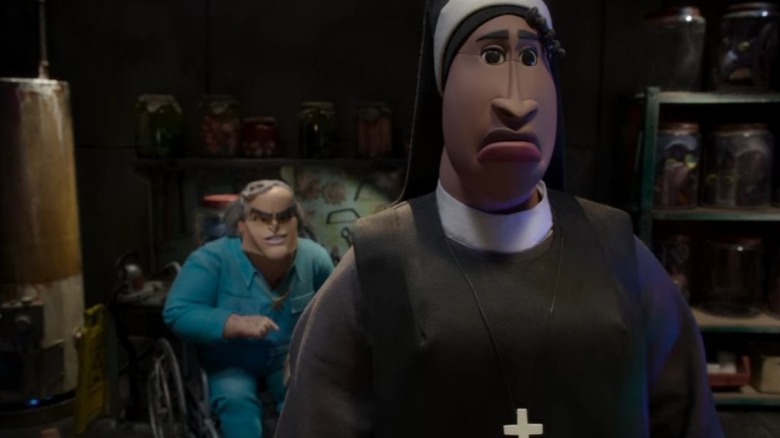Things Only Adults Notice In Wendell & Wild
The films of Henry Selick have always straddled the line between kid-friendly and adult content. For instance, "The Nightmare Before Christmas" is cartoony and playful, reminiscent of family-friendly holiday specials, but it also touches on themes of depression and showcases the filmmakers' rather gruesome imaginations. Meanwhile, "Coraline" goes to rather daring places (complete with creepy rats and near-naked old ladies) while still retaining its colorful and fanciful aesthetic; Everything in the film is seen through the eyes of a child. "Wendell & Wild" continues that tradition, though it leans significantly more toward the "adult" camp — so much so that it garnered a PG-13 rating.
Although there's plenty in "Wendell & Wild" that kids will enjoy, it also has more than a few moments that will go over their heads, perhaps aiming more squarely at their parents. What seems to be a straightforward film about an orphaned girl named Kat (Lyric Ross) befriending two demons is actually a multilayered story about loss and trauma (and also the immorality of private prisons). Here's every detail from "Wendell & Wild" that was meant for the adults in the audience.
Rust Bank is a Rust Belt town
"Wendell & Wild" never confirms where exactly the fictional town of Rust Bank is, but the film plants lots of clues that it falls somewhere in the Rust Belt. Kat's hometown is a former manufacturing hub (in this case, a brewery) that crumbled after its main source of employment closed down. Rust Bank has been reduced to a ghost town with boarded-up homes and shops. The film also includes some wealthy opportunists — Lane (David Harewood) and Irmgard (Maxine Peake) Klaxon — who exploit the community with promises of economic revitalization, a common occurrence in Rust Belt cities like Niagara, New York. The town's location is canonically confirmed in a split-second shot of Father Bests (James Hong) reading a file on Kat, which says that her parole was granted by the Great Lakes Division for Children, Youths, and Families. As you may have already guessed, the Rust Belt falls squarely in the Great Lakes region (per Investopedia).
Adults will also notice that Rust Bank is a classic example of a food desert. Whenever Wendell (Keegan-Michael Key) and Wild (Jordan Peele) demand that Kat bring them takeout, there is only one place she can go: Fawzi's Falafel truck. It appears as though grocery stores are few and far between, and all the other restaurants have gone out of business, leaving the residents of Rust Bank with not enough options to maintain a healthy diet. This is another all-too-real detail that lends authenticity to the movie.
Wendell and Wild are getting high on hair cream
Although it sounds crazy out of context, the plot of "Wendell & Wild" revolves around a tube of magic hair cream. Wendell and Wild squirt it onto the scalp of the gigantic Belzer (Ving Rhames) so he'll sprout hair. However, the pair soon discovers another use for the cream after Wild begins swallowing huge globs of it. "It tickles my tummy," he says, and any kids in the audience will take his words at face value. Grown-ups, however, will know that Wendell and Wild are taking much stronger stuff.
There's no doubt about it: Belzer's magic hair cream is the demon equivalent of a drug. (It's unclear if the hair cream has that same overpowering effect on humans.) Whenever Wendell and Wild slurp it down, they show all the symptoms of being stoned: slurred speech, uncontrollable giggles, and spiral eyes. The cream takes a few seconds to kick in, but once it does, they are flying high. Soon the two doped-up demons collapse in a heap, while the ground seems to undulate like a waterbed beneath them. They even have a hallucination about meeting a teenage Hell Maiden from the Land of the Living — no wait, that actually happens.
Of course, the magic cream also brings people back from the dead, which is where the similarities to drugs stop.
Henry Selick's version of hell is an amusement park
In "Wendell & Wild," departed souls spend their afterlife in the Scream Faire, a theme park designed for eternal torment. Kids will probably be peeking between their fingers in fright — or they might be laughing at the absurd scenario. But we suspect not many will recognize its significance. The Scream Faire is basically the director's personal vision of hell. Just as Dante's "Inferno" dreamed up a special section of hell for each of the seven deadly sins, Henry Selick invents his own twisted punishment for souls. Of course, in the world of "Wendell & Wild," not all sinners spend eternity on Belzer's belly. "It's where the souls of the danged to go — not the damned, but the danged," Selick explained in an interview with Collider. "You know, the crooked lawyers, the meter maids, the bad people, but not the truly bad."
Selick stumbled upon the idea for this while visiting a real-life amusement park in New Jersey: Asbury Park. The director recalled in a press release (via Mama's Geeky) that he met a ride operator who would often crank up the ride to its maximum speed, until the riders began to worry he might never let them get off. "Everybody on the ride was screaming at him to stop," said Selick, "and he just was laughing his head off." Only Selick's twisted imagination could come up with the brilliant concept of using an amusement park for eternal punishment.
Kat is repressing her trauma
Although "Wendell & Wild" appears to simply be about a teenage girl and two demons, the deeper story is about Kat healing from past trauma. Adults in the audience will be able to appreciate Kat's psychological journey.
The film begins on a bold note. It plunges viewers right into the deep end in the opening scene by showing Kat's parents sinking to their watery graves. Kat blames herself for her parents' deaths. She tells other characters and the audience that her parents would still be alive if she hadn't screamed in surprise, causing them to veer off the road. Of course, there's another unspoken reason why she feels like it's her fault. During the crash, Kat's mother (Gabrielle Dennis) urged her to swim to the surface, while she tried to rescue her unconscious husband (Gary Gatewood). Kat now has recurring nightmares about the moment she swam free of the car and watched it sink, too paralyzed to help her parents. The guilt of not doing anything to save them has eaten away at Kat for years.
Since the accident, Kat has repressed her emotions, even her fondest memories of her parents. "Good memories, they can hurt the most," she explains. She won't allow herself to get close to anyone, insisting, "Bad things happen to the people I'm close to." Only by the end of the movie does Kat learn to let people in again.
The school-to-prison pipeline has scarred Kat
The movie doesn't show us too much of Kat's experiences bouncing from school to school before she ends up at Rust Bank Catholic (RBC). But it does drop some hints, suggesting a backstory that's way darker than meets the eye.
In the scene where Kat must relive her most painful memories, we get a glimpse of the sinister Mother Goose Group Home and an uncaring judge. Most disturbingly, we see Kat being tormented by a bully, only to respond by pushing him down a flight of stairs. That must have been extremely traumatizing — not just because Kat clearly got blamed for the whole incident, but also because she likely blames herself.
Viewers will also notice that Kat gets suspicious every time an adult tries to help her. This isn't just because she's a rebellious teenager; the movie implies that her previous experiences in juvenile detention schools have destroyed her trust in grown-ups. Sometimes, this mistrust is earned. (Kat was right on the money when she accused Father Bests of only taking her in so he could snag more funds for his school.) Still, at other times this means Kat pushes away the very people that could help her. For instance, when Sister Helley (Angela Bassett) orders Kat to tell nobody about her Hell Maiden mark, Kat immediately assumes that Helley just wants to keep it under wraps so she won't get fired.
Kat's exorcism is a form of therapy
An exorcism is the last thing any respectable psychiatrist would prescribe for a teenager dealing with the baggage of childhood trauma. But for Kat, an exorcism is exactly what she needs to heal. When Sister Helley purges Kat of the curse that Wendell and Wild put on her, it doubles as a therapeutic catharsis for Kat.
"Your memories are what fuel the fever," Helley tells Kat. In order to break free of her curse, Kat must first come to terms with her past trauma. The specter of her past has been repressed for so long that it has grown into a physical entity, which manifests itself as a shadow-puppet monster made up of bits and pieces of Kat's worst memories. This is a metaphor for Kat's trauma and her guilt about her parents' deaths that allows the demons access into her subconscious. It's the chink in her armor that gives Wendell and Wild sway over her.
Yet it is Kat's tragic past that ultimately helps her beat the curse. "You've tortured me for years," she tells the shadow monster. "But you've made me a survivor." Kat's tough life has given her an equally tough spirit, allowing her to take ownership of her tragic history and tear the shadow monster apart. Along the way, she discovers that neither are quite as scary as they seem — an important takeaway about healing for any viewers who look deep enough.
The film's musical influences span generations
Not all teenagers watching "Wendell & Wild" may be aware of the rich musical history behind the soundtrack of "Wendell & Wild." The movie includes songs from various genres and stretches across multiple generations. For instance, there are songs from the '70s and '80s that Kat's parents would have listened to (like "Ma and Pa" by Fishbone and "GermFree Adolescence" by X-Ray Spex) alongside more recent Gen Z songs (like "River" by Ibeyi). Henry Selick told Nerdist that he wanted to celebrate the early bands from the '70s and '80s that helped launch the Afropunk genre, which he felt weren't getting enough attention.
The movie's score has a strong Afropunk vibe, but it wasn't always this way. An earlier version of the story positioned Sister Helley as the main character, with Kat only existing in a supporting role, says Nerdist. Before Kat became the main character, the filmmakers were picturing a Motown soundtrack, according to music supervisor Rob Lowry in an interview with Tudum. Once the movie's focus shifted toward Kat, the music shifted, too. The filmmakers began gravitating toward the kind of music Kat liked, which meant featuring Afropunk artists like Big Joanie and X-Ray Spex. Lowry argues that the film is better for it, because Kat's story and her taste in music is much more distinctive.
Raúl is trans
Although openly LGBTQ+ cartoon characters are becoming more commonplace, it's still pretty rare to see openly trans characters in mainstream animated movies that are aimed at families. Enter Raúl (Sam Zelaya), an openly transgender teenager from "Wendell & Wild." The movie doesn't necessarily spell it out for viewers, but it doesn't skirt around the subject, either. Anyone who is paying attention will pick up on the clues that canonically confirm Raúl is trans.
For one, viewers will notice that the characters refer to Raúl using he/him pronouns, even though RBC Girls appears to be an all-girl school. As well, Raúl's mom Marianna (Natalie Martinez) is overheard telling her boss, "I have a son to feed." Her employer's response isn't audible, but he is probably asking her if she meant "daughter," because Marianna replies emphatically, "No, a son, remember?" Early in the movie, Raúl mentions he used to be close with Siobhan (Tamara Smart) and the other preppy girls (whom Kat dubs "the poodles"). Later, he shows Kat a photo of his younger self, posing in a skirt next to the poodles. But the biggest clue is revealed whenever Siobhan slips up and calls her old friend by the name "Ramona" (his name assigned at birth). Seeing Raúl's reaction, she immediately apologizes and calls him "Raúl," which leaves no doubt about Raúl's gender identity.
Klax Korp's evil plan isn't so far-fetched
Even though "Wendell & Wild" is a fantastical film, it's also grounded in the real world. Henry Selick said in an interview with /Film, "I always wanted the villains to be humans," as opposed to demons. Here, the villains are the Klaxons, who plan to bulldoze Rust Bank and use Kat's school to funnel juvenile delinquents into their private prison. Their evil plot may seem over the top at first. After all, no private prison has ever relied on zombie votes to get approval to break ground. Still, adults will recognize uncomfortable real-life parallels. The scene in which Siobhan discovers the truth behind her parents' "business model" pretty much hits a nail on the head. Since private prisons get paid for every inmate they bring in, explains Esquire, that means they are incentivized to incarcerate as many people as possible and keep them incarcerated — rehabilitation be danged.
Also, the Klaxons unroll a sign that reads "Make way for jobs" to convince Rust Bank to approve their new prison. This is common rhetoric used by advocates for private prisons, even though there is no evidence that prisons boost economic growth, according to Prison Legal News. In any event, any jobs the Klaxons provide could hardly be considered good jobs: The Klaxons pay their employees in Klax Kash, which Siobhan points out is "worthless in the real world." Klax Kash may be loosely based on company scrip, which was given to coal miners as advanced payment and could only be used in the company store, according to Appalachian History.
RBC practices corporal punishment
In the scene where Kat and Raúl are sent to detention, they must write "Thou shalt not hold Father Bests hostage" on a blackboard dozens of times. Even worse, the two are locked in the detention room, forced to listen to two nuns playing the accordion. (That seems like a special kind of torture that ought to be reserved only for the Scream Faire.) Of course, a blink-and-you-miss-it moment reveals that RBC has also relied on even more severe forms of punishment in the past.
Observant adults will notice that the detention room has several instruments of punishment framed and hung on the wall, almost like a trophy case. The school walls proudly display an array of belts, rulers, and wooden spoons that have been used on students' wrists and bottoms in the past. Up on the wall with them is a bar of soap (perfect for washing out the mouths of potty-mouthed pupils) as well as a single sandal (which was no doubt used to give an unfortunate kid "the chancla"). There's also a painting of a nun administering a spanking to a boy whose crime appears to be the half-eaten lollipop in his hands. There's even a wooden paddle labeled with a delicious pun: "Board of Education." This moment is one of the movie's best sight gags, though it will go over most younger viewers' heads.
There's a reason why the characters have cracks in their faces
If you watch even a few minutes of "Wendell & Wild," you'll notice that almost every character has a crack running down the middle of their faces. There's a seam at eye level that splits their faces in half. Kids probably won't even give it a second thought, but adult animation enthusiasts will recognize how significant this is.
The movie uses replacement animation, meaning that the animators remove the faces of each puppet and replace them with different facial expressions. According to Mashable, it's more convenient for the animators to split the face into two separate pieces, so they can get more combinations of facial expressions. Director Henry Selick simply chose not to hide this fact. He told Indiewire, "On [my previous film] 'Coraline,' it wasn't my call, but they chose to paint out that seam line in post [production]," so nobody would see the seam lines in the final film. Before "Wendell & Wild," it was customary for stop-motion films to edit out the seam lines, to make the final film appear as realistic as possible. (Previously only "Anomalisa" broke this unspoken rule.) Netflix finally gave the director a chance to use this technique with "Wendell & Wild."
Selick explained to Collider that he wanted to preserve the seams and all the imperfections in the animation to visually distinguish his work. By not hiding the seams, Selick is reminding viewers of all the care that went into animating "Wendell & Wild."
